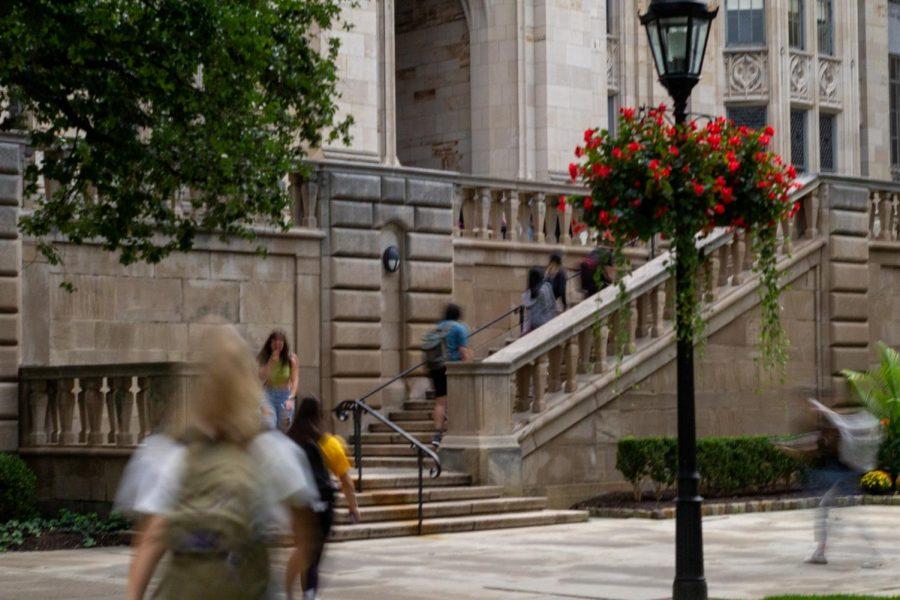Professors experiment with ungraded courses
John Blair | Senior Staff Photographer
Students walk to their classes at the Cathedral of Learning.
January 26, 2022
After watching her students struggle throughout the COVID-19 pandemic, Kat Lieder felt it was time to implement some changes in her classroom.
Lieder, a visiting professor of contemporary global studies, wanted to form better relationships with her students and began using the “ungrading” course model last spring.
“It was an acknowledgment of the challenges we’re all facing, but also a chance to focus more on learning for the sake of learning, instead of learning for the sake of getting a good grade,” Lieder said.
Some professors at Pitt have begun moving away from operating their courses in a traditional, graded manner and are experimenting with two new approaches called specifications grading and ungrading.
Lieder, who uses the ungrading system, said students are not graded on their assignments rather they determine what their final grade will be in consultation with their professor at the end of the semester.
Scott Kiesling, a professor of linguistics who chairs that department, uses the specifications grading method. He said final grades are determined by how many assignments a student completes, and each assignment is not graded.
“Specifications grading in short is based on how much you complete, not how well you complete it,” Kiesling said. “In my classes you either get a one or a zero. If they turn it in they get a one, and if they don’t, they get a zero.”
Kiesling said he began exploring specifications grading at the end of the 2020-21 academic year. He contemplated what purpose grading served for both him and his students, and realized it did not help their learning.
“The feedback you get from grades doesn’t help, and the only thing it’s there for is for other people to be able to sort and judge students,” Kiesling said. “That kind of troubled me given that my goal is to be inclusive.”
Lieder said she sets goals with her students at the beginning of the semester based on their “desires and needs” for the course, and does not grade a single assignment. At the end of the semester, students put together a portfolio of their work, write a brief statement about whether they think they met their goals set at the beginning of the semester and communicate what grade they think they deserve.
“Students evaluate one another’s work, they talk with me about what they think is going on orally and they can ask me for more specific feedback if they’d think it would be helpful,” Lieder said. “I do it face to face so it’s a conversation, rather than me telling them what’s right and wrong.”
Lieder said her students responded to the ungrading model “very positively,” but some showed initial hesitation.
“With my students who were used to getting A’s in their classes, they sometimes get nervous at the beginning of the semester because they’re so used to external approval being how they measure their self-worth,” Lieder said. “Part of ungrading is teaching students that your self-worth shouldn’t be based on someone else. It should be based on you.”
Maja Lynn, a senior anthropology and museum studies major, took Lieder’s global studies capstone course this past fall. She said she “really enjoyed” the way the course was run, and that the positive relationship with her professor motivated her to want to produce better work.
“Initially it was intimidating for students to not have a measurement on our work, but I think it was actually more motivating because you have the space to decide what matters to you or what directions you want to take things in,” Lynn said. “The pressure is off to satisfy a professor and instead you’re satisfying your own intellectual needs.”
Lynn said she thinks her experience taking the course was beneficial because she had more control over what she was doing. Despite not receiving grades, Lynn said the workload was equivalent to traditionally run courses and each student produced nearly 50 pages of written work by the end of the semester.
“It doesn’t mean you aren’t expected to produce work — I was still expected to give a final portfolio, assess my own work and talk about what I believed I deserved for a grade,” Lynn said. “There’s still expectations and there’s still a high level of engagement.”
Kiesling said the model he uses eliminates the stress of worrying about what grade each assignment will receive, and allows students to further engage with course material.
“They focus on the content more rather than worrying about whether they’re doing it in the way I want them to do it,” Kiesling said. “I think I’ve actually seen an increase in motivation in terms of engagement with the material rather than a decrease.”
Kiesling said specifications grading restored his love for teaching. He said it allows for students to take ownership of their learning and thinks it’s “something everybody should try.”
“We have to make the material available, we have to give activities that promote learning and we still have to be as thoughtful as before in designing the courses, but it’s up to students to engage with the material and do the learning,” Kiesling said. “I think every class has the potential for that.”






